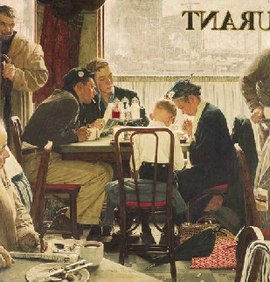
Back Saying Grace Danish Dando gracias (Rockwell) Spanish Le Bénédicité (Rockwell) French സേയിങ് ഗ്രേസ് (റോക്ക്വെൽ) Malayalam Застольная молитва (картина Роквелла) Russian
| Saying Grace | |
|---|---|
 | |
| Artist | Norman Rockwell |
| Year | 1951 |
| Medium | Oil on canvas |
| Dimensions | 110 cm × 100 cm (42 in × 40 in) |
| Location | Private collection |
Saying Grace is a 1951 painting by American illustrator Norman Rockwell, painted for the cover of The Saturday Evening Post's November 24, 1951, Thanksgiving issue.[1][2][3]
The painting depicts a woman and a young boy saying grace in a crowded restaurant, as they are observed by other people at their table.[3] Rockwell's inspiration for Saying Grace came from a Saturday Evening Post reader who saw a Mennonite family praying in a restaurant.[1] Rockwell used his son, Jarvis, as one of the models for the painting.[1] Elizabeth Goldberg, director of American Art at Sotheby's said that in his preparations for Saying Grace Rockwell "... visited Automats and diners in New York and Philadelphia to get the scene just right ... his imagery was so vivid people would say they recognized the diner even though it didn't exist, each painting felt so universal."[2] Rockwell took the table and chairs from a diner in Times Square for the photo shoot for the painting.[2] In preparations for a painting Rockwell would set up a scene, using his friends and neighbors, taking hundreds of photos until satisfied. Rockwell would produce sketches in charcoal, then oil sketches, before painting the final image.[2]
Rockwell was paid $3,500 (equivalent to $41,085 in 2023)[4] for Saying Grace.[2] Readers of The Saturday Evening Post voted Saying Grace their favorite ever cover in 1955.[1] Saying Grace had been on a long-term loan at the Norman Rockwell Museum, and had been exhibited at 12 other museums across the United States before its 2013 sale.[3]
- ^ a b c d Cite error: The named reference
Guardwas invoked but never defined (see the help page). - ^ a b c d e Carol Vogel (18 September 2013). "Norman Rockwell's America, Newly Up for Bid". The New York Times. Retrieved December 4, 2013.
- ^ a b c "Norman Rockwell's 'Saying Grace' Sells For $46 Million At Auction". National Public Radio. Retrieved December 5, 2013.
- ^ 1634–1699: McCusker, J. J. (1997). How Much Is That in Real Money? A Historical Price Index for Use as a Deflator of Money Values in the Economy of the United States: Addenda et Corrigenda (PDF). American Antiquarian Society. 1700–1799: McCusker, J. J. (1992). How Much Is That in Real Money? A Historical Price Index for Use as a Deflator of Money Values in the Economy of the United States (PDF). American Antiquarian Society. 1800–present: Federal Reserve Bank of Minneapolis. "Consumer Price Index (estimate) 1800–". Retrieved February 29, 2024.
© MMXXIII Rich X Search. We shall prevail. All rights reserved. Rich X Search